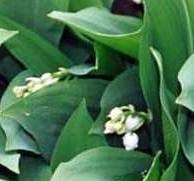Lily of the Valley
The Lily of the Valley grows wild in many of our English woods, and possesses special curative virtues, which give it, according to modern knowledge, a just place among Herbal Simples of repute.
Added Sep 9, 2010
| 7,238 Reads
This is the parent flower of our graceful, sweet-scented scape of pendent, milk-white little floral bells, enshrined within two broad leafy blades of dark green, and finding general favour for the jardinière, or the button-hole. Its name Convallaria majalis is derived from convallis, "a valley," and majalis, "belonging to the month of May," when this Lily comes into flower. Rustics corrupt the double title to "Liry Confancy," and provincially the plant is known as "Wood Lily," "May Lily," and "May Blossom." Also it bears the name of Mugget, and is said to have grown up after the bloody combat of St. Leonard with the Dragon. The French call it Muguet, or "little musk." The taste of the flowers is acrid and bitter; they have been employed with benefit, when dried and powdered, as snuff, for headache, and giddiness arising from weakness. A tincture of the plant is made, and can be procured from any leading druggist. The active medicinal principle is "convallarin," which slows the disturbed action of a weak, irritable heart, whilst at the same time increasing its power. Happily the remedy is a perfectly safe one, and no harm has been known to occur from taking it experimentally in full and frequent doses; so that, in this respect, it is far preferable to the Fox Glove, which is apt to accumulate in the blood with poisonous results. To make the tincture of Convallaria, one part of the flowers is treated with eight parts of spirit of wine (proof); and the dose is from five to fifteen drops, with a tablespoonful of water, three times in the twenty-four hours. Also an infusion may be made with boiling water poured over the whole plant-root, stems, and flowers; and this infusion may be given continuously for from five to ten days; but it should be left off for a time as soon as the irritability of the heart is subdued, and the pulse steady and stronger. If taken during an attack of palpitation and laboured breathing from a weak heart, the benefit of the infusion in tablespoonful doses is felt at once. Ten grains of the dried flowers may be infused in six ounces of boiling water; and a tablespoonful of this be given three times a day with perfect safety, and with a most soothing effect for a weak, sensitive, palpitating heart; but it does not suit a fatty heart equally well. Nevertheless, even for insufficiency of the valves, when dangerous, or distressing symptoms of heart disease have set in, an infusion of the flowers has proved very helpful. The rhizome, root, exhales a pleasant odour, different from that of the flowers; it tastes sweet at first but afterwards bitter. A fluid extract is further prepared, and may be mixed in doses of from five to twenty drops with water. The Russian peasants have long employed the Lily of the Valley for certain forms of dropsy, when proceeding from a faulty heart. In the summer, when the flowers are in bloom, two drachms, by weight, of the leaves should be steeped in a pint of water, either cold or boiling; and the whole of this may be taken, if needed, during the twenty-four hours. It will promote a free flow of urine. Culpeper commended the Lily of the Valley for weak memory, loss of speech, and apoplexy; whilst Gerard advised it for gout. In Devonshire it is thought unlucky to plant a bed of these Lilies, as the person who does so will probably die within the next twelve months. In the Apocrypha, Canticles ii, I, "I am the Lily of the Valley," this flower is apparently brought under notice, but some other plant must be intended here, because the Lily Convally does not grow in Palestine. The word Lily is used in Oriental languages for a flower in general. Distilled water from the flowers was formerly in great repute against nervous affections, and for many troubles of the head, insomuch that it was treasured in vessels of gold and silver. Matthiolus named it Aqua aurea, "golden water"; and Etmuller said of the virtues of the plant, Quod specifice armabit impotentes maritos ad bellum veneris. A spirit made from the petals is excellent as an outward embrocation for rheumatism and sprains; and in some parts of Germany, a wine is prepared from the flowers mixed with raisins. Old Gerard adopted an unaccountable method for extracting these virtues of the Lilies. He ordered that, "The flowers being close stopped up in a glass vessel, should be put into an ant hill, and taken away again a month after, when ye shall find a liquor in the glass which, being outwardly applied, will help the cure of the gout." After the blossom has fallen off a berry is formed, which assumes in the autumn a bright scarlet colour, and proves attractive to birds.
Added Sep 9, 2010
| 7,238 Reads
Share The Magic ...
The GoE MONEY!!! Course - A Course In Real MONEY MAGIC!
|





















